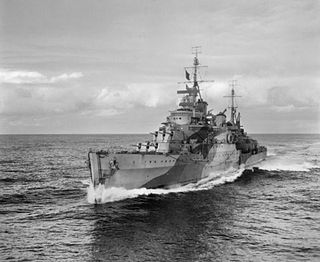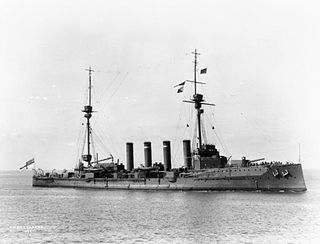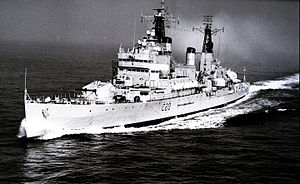
The Tiger class were a class of three British warships of the 20th century and the last all-gun cruisers of the Royal Navy. Construction of three Minotaur-class cruisers began during World War II but, due to post-war austerity, the Korean War and focus on Royal Air Force over the surface fleet, the hulls remained unfinished. Against a background of changing priorities and financial constraints, approval to complete them to a modified design was given in November 1954 and the three ships – Tiger, Lion and Blake – entered service from March 1959.

HMS Blake was a light cruiser of the Tiger class of the British Royal Navy, the last of the (traditional) Royal Navy gun-armed cruisers in the 20th century. She was named after Robert Blake, a 17th-century admiral who was the "Father of the Royal Navy". She was ordered in 1942 as one of the Minotaur class of light cruisers. They had a low construction priority due to more pressing requirements for other ship types during World War II, particularly anti-submarine craft.

The Town class consisted of 10 light cruisers built for the Royal Navy during the 1930s. The Towns were designed to the constraints imposed by the London Naval Treaty of 1930. The ships were built in three distinct sub-classes, the Southampton, Gloucester and Edinburgh classes respectively, each sub-class adding on further weaponry.

The County class was a class of heavy cruisers built for the Royal Navy in the years between the First and Second World Wars. They were the first post-war cruisers constructed for the Royal Navy and were designed within the limits of the Washington Naval Treaty of 1922. Such ships, with a limit of 10,000 tons, standard displacement and 8-inch calibre main guns may be referred to as "treaty cruisers".

The York class was the second and final class of heavy cruisers built for the Royal Navy under the terms of the 1922 Washington Naval Treaty. They were essentially a reduced version of the preceding County class, scaled down to enable more cruisers to be built from the limited defence budgets of the late 1920s.

The Leander class was a class of eight light cruisers built for the Royal Navy in the early 1930s that saw service in World War II. They were named after mythological figures, and all ships were commissioned between 1933 and 1936. The three ships of the second group were sold to the Royal Australian Navy (RAN) before World War II and renamed after Australian cities.

The Minotaur class, also known as the Swiftsure class after the lead ship was sold to Canada and renamed, were a group of light cruisers of the British Royal Navy built during the Second World War. They were designed as a modified version of the Fiji class incorporating war modifications and authorised in 1941. However, in spite of the heavy toll of cruisers in that year and the following one, the building of this new class had a relatively low priority and only three of the planned twelve were completed by end of World War II. They played no significant part in the Second World War, though Swiftsure, as flagship of the British Pacific Cruiser Squadron, was selected by Admiral Cecil Harcourt to hoist his flag for the Japanese surrender at Hong Kong.

The QF 4.5 inch gun has been the standard medium-calibre naval gun used by the Royal Navy as a medium-range weapon capable of use against surface, aircraft and shore bombardment targets since 1938. This article covers the early 45-calibre family of guns up to the 1970s. For the later unrelated 55-calibre Royal Navy gun, see 4.5 inch Mark 8 naval gun. Like all British nominally 4.5 inch naval guns, the QF Mk I has an actual calibre of 4.45 inches (113 mm).

The Arethusa class was a class of four light cruisers built for the Royal Navy between 1933 and 1937 and that served in World War II. It had been intended to construct six ships, but the last pair, Polyphemus and Minotaur, were ordered in 1934 as the 9,100-ton Town-class Southampton and Newcastle.

HMS Defence was a Minotaur-class armoured cruiser built for the Royal Navy in the first decade of the 20th century, the last armoured cruiser built for the Royal Navy. She was stationed in the Mediterranean when the First World War began and participated in the pursuit of the German battlecruiser SMS Goeben and light cruiser SMS Breslau. The ship was transferred to the Grand Fleet in January 1915 and remained there for the rest of her career.

The Hawkins class consisted of five heavy cruisers built for the Royal Navy during the First World War, although none of them saw service during the war. The first ship to be completed, HMS Vindictive, was renamed from HMS Cavendish and converted into an aircraft carrier while under construction. All ships were named after Elizabethan sea captains. The three ships remaining as cruisers in 1939 served in the Second World War, with Effingham being an early war loss through wreck; Raleigh had been lost in a similar shipwreck on uncharted rocks in 1922. Vindictive, though no longer a cruiser, also served throughout the War. This class formed the basis for the definition of the maximum cruiser type under the Washington Naval Treaty of 1922.

The Minotaur class was a three-ship class of armoured cruisers built in the first decade of the twentieth century for the Royal Navy. These were the last class of armoured cruisers built for the Royal Navy, with that role being substantially replaced by the first battlecruisers. These initially served with the Home Fleet, generally as the flagships of cruiser squadrons. Minotaur became flagship of the China Station in 1910 and Defence served as flagship of the 1st Cruiser Squadron in the Mediterranean from 1912; Shannon remained at home as flagship of several different squadrons.

HMS Swiftsure was one of three Minotaur-class light cruisers built for the Royal Navy during the Second World War. She was laid down by Vickers Armstrong at Newcastle upon Tyne on 22 September 1941, launched on 4 February 1943 by Lady Wake-Walker and commissioned on 22 June 1944. The first of a new Minotaur class, a development of the later Colony class with extra beam and a fifth twin 4 inch turret. Swiftsure was the last Royal Navy cruiser completed during World War II and was the first British cruiser designed around the concept of an operations room and modern radar, with sensor screens and communications positioned for efficient operation. During her service in the Pacific in 1945, she proved the most efficient anti-aircraft cruiser in the fleet and was the first Royal Navy cruiser with the Type 274 lock-and-follow radar targeting system for her main armament.

HMS Cochrane was a Warrior-class armoured cruiser built for the Royal Navy in the first decade of the 20th century. She served in the 2nd Cruiser Squadron during the First World War under Rear-Admiral Herbert Heath, taking part in the Battle of Jutland in 1916. She was based in Murmansk in mid-1918 during the Allied intervention in the Russian Civil War. She became stranded in the River Mersey on 14 November 1918 and broke in two. The wreck was broken up in place by June 1919.

HMS Minotaur was the lead ship of the Minotaur-class armoured cruisers built for the Royal Navy. Launched in 1906, she served as the flagship of the China Station before the First World War. Shortly after the war began, the ship searched unsuccessfully for the German East Asia Squadron and was transferred to the Grand Fleet at the end of 1914. During the rest of the war Minotaur served as the flagship of the 7th and 2nd Cruiser Squadrons and spent most of her time assigned to the Northern Patrol. In mid-1916 she participated in the Battle of Jutland but did not fire her weapons during the battle. The ship was paid off in 1919 and sold for scrap the following year.

HMS Shannon was a Minotaur-class armoured cruiser built for the Royal Navy in the mid-1900s. Before the First World War, she served with the Home Fleet, generally as the flagship of a cruiser squadron. The ship remained with the Grand Fleet, as the Home Fleet was renamed when the war began, for the entire war, but only participated in a single battle, the Battle of Jutland in May 1916. Shannon spent most of the war unsuccessfully patrolling the North Sea for German warships and commerce raiders. She was paid off in 1919 and sold for scrap in 1922.

The QF 5.25-inch Mark I gun was the heaviest dual-purpose gun used by the Royal Navy during the Second World War. Although considered less than completely successful, it saw extensive service. 267 guns were built.

The QF 4 inch Mk XVI gun was the standard British Commonwealth naval anti-aircraft and dual-purpose gun of World War II.
The Neptune class was a proposed class of cruisers planned for the British Royal Navy in the latter years of the Second World War. They were large ships which were to be armed with twelve 6-inch (152 mm) dual-purpose guns and with a heavy secondary armament. Although five ships of the class were planned in 1944, they were cancelled following the end of the war, before construction could begin.
The Minotaur class, or Design Z, was a proposed class of light cruisers planned for the British Royal Navy shortly after the Second World War. Design Z had several proposed configurations with differing armament and propulsion arrangements. The designs were large ships that were planned to be armed with ten 6 in (152 mm) dual purpose guns and an extensive array of 3 in (76 mm) secondary guns. Six ships of the class were planned in 1947 but they were ultimately cancelled before construction could begin, owing to the post-war economic difficulties of the United Kingdom and shifting naval priorities.
















